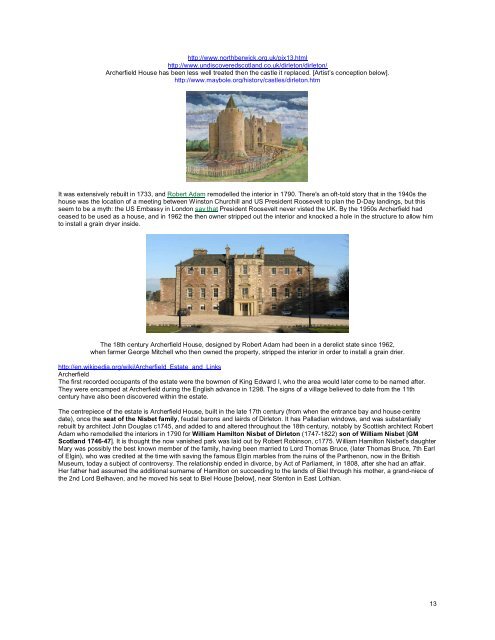Grand Masters of Scotland - Onondaga and Oswego Masonic ...
Grand Masters of Scotland - Onondaga and Oswego Masonic ...
Grand Masters of Scotland - Onondaga and Oswego Masonic ...
Create successful ePaper yourself
Turn your PDF publications into a flip-book with our unique Google optimized e-Paper software.
http://www.northberwick.org.uk/pix13.html<br />
http://www.undiscoveredscotl<strong>and</strong>.co.uk/dirleton/dirleton/<br />
Archerfield House has been less well treated then the castle it replaced. [Artist’s conception below].<br />
http://www.maybole.org/history/castles/dirleton.htm<br />
It was extensively rebuilt in 1733, <strong>and</strong> Robert Adam remodelled the interior in 1790. There's an <strong>of</strong>t-told story that in the 1940s the<br />
house was the location <strong>of</strong> a meeting between Winston Churchill <strong>and</strong> US President Roosevelt to plan the D-Day l<strong>and</strong>ings, but this<br />
seem to be a myth: the US Embassy in London say that President Roosevelt never visted the UK. By the 1950s Archerfield had<br />
ceased to be used as a house, <strong>and</strong> in 1962 the then owner stripped out the interior <strong>and</strong> knocked a hole in the structure to allow him<br />
to install a grain dryer inside.<br />
The 18th century Archerfield House, designed by Robert Adam had been in a derelict state since 1962,<br />
when farmer George Mitchell who then owned the property, stripped the interior in order to install a grain drier.<br />
http://en.wikipedia.org/wiki/Archerfield_Estate_<strong>and</strong>_Links<br />
Archerfield<br />
The first recorded occupants <strong>of</strong> the estate were the bowmen <strong>of</strong> King Edward I, who the area would later come to be named after.<br />
They were encamped at Archerfield during the English advance in 1298. The signs <strong>of</strong> a village believed to date from the 11th<br />
century have also been discovered within the estate.<br />
The centrepiece <strong>of</strong> the estate is Archerfield House, built in the late 17th century (from when the entrance bay <strong>and</strong> house centre<br />
date), once the seat <strong>of</strong> the Nisbet family, feudal barons <strong>and</strong> lairds <strong>of</strong> Dirleton. It has Palladian windows, <strong>and</strong> was substantially<br />
rebuilt by architect John Douglas c1745, <strong>and</strong> added to <strong>and</strong> altered throughout the 18th century, notably by Scottish architect Robert<br />
Adam who remodelled the interiors in 1790 for William Hamilton Nisbet <strong>of</strong> Dirleton (1747-1822) son <strong>of</strong> William Nisbet [GM<br />
<strong>Scotl<strong>and</strong></strong> 1746-47]. It is thought the now vanished park was laid out by Robert Robinson, c1775. William Hamilton Nisbet's daughter<br />
Mary was possibly the best known member <strong>of</strong> the family, having been married to Lord Thomas Bruce, (later Thomas Bruce, 7th Earl<br />
<strong>of</strong> Elgin), who was credited at the time with saving the famous Elgin marbles from the ruins <strong>of</strong> the Parthenon, now in the British<br />
Museum, today a subject <strong>of</strong> controversy. The relationship ended in divorce, by Act <strong>of</strong> Parliament, in 1808, after she had an affair.<br />
Her father had assumed the additional surname <strong>of</strong> Hamilton on succeeding to the l<strong>and</strong>s <strong>of</strong> Biel through his mother, a gr<strong>and</strong>-niece <strong>of</strong><br />
the 2nd Lord Belhaven, <strong>and</strong> he moved his seat to Biel House [below], near Stenton in East Lothian.<br />
13







![Richard [Nicholls] Harison / Harrison - Onondaga and Oswego ...](https://img.yumpu.com/24950065/1/190x245/richard-nicholls-harison-harrison-onondaga-and-oswego-.jpg?quality=85)
![Richard [Nicholls] Harison / Harrison - Onondaga and Oswego ...](https://img.yumpu.com/24950063/1/190x245/richard-nicholls-harison-harrison-onondaga-and-oswego-.jpg?quality=85)








